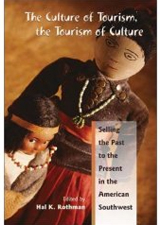Book Review
The Culture of Tourism, the Tourism of Culture: Selling the Past to the Present in the American Southwest
Edited by Hal K. Rothman. Albuquerque: University of New Mexico Press, 2003; 250 pp., illustrations, photographs, notes; cloth $34.95.
 |
In the introduction to this book, editor Hal Rothman suggests that the Southwest provided the model upon which Americans discovered tourism. While far from accurate, that observation points faithfully to the importance of the southwestern United States in demonstrating the complex and often perplexing human consequences of modern tourism. The book's interdisciplinary focus also provides testimony to the degree to which issues related to tourism and travel have begun to catch the attention of a variety of disciplines and areas of professional practice.
One of the unique features of southwestern tourism lies in the tricultural and highly racialized identities associated with the American Southwest. In her contribution, Sylvia Rodriquez describes how tourism has contributed to and reflects the construction in New Mexico of an Indian-Mexican-Anglo identity that serves to misrepresent the true complexity of ethnic differences in the region and is continually renegotiated through shifts in the ethnic power base of localities. Her insightful discussion of changes in regional tourism strategies due to increased Hispanic political influence and the development of casino gaming by several Indian pueblos is worthy of careful reading. Chris Wilson's article on the historical development of the touristic and monumental representation of New Mexico's three major "cultures" provides additional documentation.
Several of the contributions focus on the importance of material culture in structuring southwestern tourism. In her discussion of the important role played by "authentic" Indian-crafted souvenirs, Leah Dilworth describes how such objects can serve to appropriate and commodify cultural identities. In her critique of the Indian Arts and Crafts Act of 1990, Dilworth suggests that it actually serves to alienate rather than protect culturally appropriate modes of Indian production and identity. In "Anglo Artists and the Creation of Pueblo Worlds," Rina Swentzell offers a personal account of growing up Indian in a pueblo near the tourist mecca of Taos, contrasting her own feelings of Indian identity with representations of Indian culture produced by popular Anglo artists. In another article, Erika Marie Bsumek turns her attention to that form of "virtual tourism" represented by the collection from afar of ethnographic arts and crafts. The popularity of such elite collecting, Bsumek argues, has served to deprive some people of large parts of their material heritage, particularly when it has focused on rare, personal, and ceremonial objects, rather than on goods produced for the tourist market.
Articles by Phoebe Kropp and Marguerite Shaffer address issues related to the touristic making of southwestern places. Kropp's contribution describes the early-20th-century construction of the El Camino Real highway along the California coast, with emphasis on the advent of the automobile as a touring vehicle and the highly romanticized and racialized revival, if not reinvention, of California's early Spanish missions. Shaffer's particularly insightful article is based modestly enough on pre-World War II travel scrapbooks of a secretary from New York. Worth noting is Shaffer's ability to find ways that the scrapbooks reflect common tourism expectations and commercial travel products while highlighting the personality of the scrapbook maker. As a result, we are able to see the traveling secretary as a part of the tourism enterprise and as an individual with particular tastes and ideas related to her travel experiences. This is important in view of critical literature (both humanistic and social scientific) that often generalizes individual tourist motivations.
Two other articles are devoted to more practical or applied aspects of southwestern tourism. William Bryan Jr., offers a useful critique of recent attempts to develop a more "appropriate" or sustainable approach to cultural tourism. Bryan praises three "working experiments" in Arizona, but also decries the fact that these examples are anomalies in an industry that, for the most part, proceeds with little caution for human and environmental consequences. In a more positive vein, Susan Guyette and David White describe their efforts to develop a strategy of cross-cultural tourism planning, based mostly on their work with southwestern Indian communities.
The final two articles are concerned with issues related to urban tourism in the Southwest. Char Miller offers an interesting account of economic ramifications of San Antonio's revitalization as a tourist town, and Hal Rothman provides an entertaining interpretation of Las Vegas, which might be said to have invented postmodern tourism before there even was such a term.
The Culture of Tourism, the Tourism of Culture is well worth reading, both for what it has to convey about the multiple features and myriad consequences of southwestern tourism and for its interdisciplinary nature. The strengths may contribute to some relatively minor weaknesses. The essays vary somewhat in the force and credibility of their arguments. Several seem too abstract in a critical or literary sense or, in a couple of cases, a bit too self-congratulatory, offering only limited evidence for their nonetheless intriguing conclusions. It seems clear that if all of the authors talked to each other, there would be a number of significant disagreements regarding the consequences of tourism and how tourism is best studied. The disagreements are inevitable; it would have been helpful to identify and discuss some of the differences.
The book also treats issues related to authenticity and significance—in some cases suggesting that tourism is a clear threat to "the real." In other instances, the authors argue that the concept of authenticity might itself be a by-product of touristic encounters, and hint that significance and representational authority might be better measures of what is going on than authenticity. Again, sorting through these differences would be helpful.
If the American Southwest is not the model for tourism—either historically or in our time—it still provides one of the more compelling instances of the complexity of tourism's consequences. This is a thought-provoking and worthwhile book.
Erve Chambers
University of Maryland, College Park
